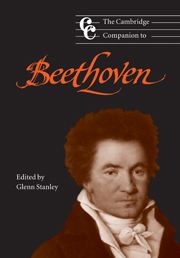Book contents
- Frontmatter
- Part I A professional portrait
- 1 Some thoughts on biography and a chronology of Beethoven's life and music
- 2 Beethoven at work: musical activist and thinker
- 3 The compositional act: sketches and autographs
- Part II Style and structure
- Part III Genres
- Part IV Reception
- Notes
- Selected further reading
- General index
- Index of Beethoven’s compositions and sketches
- Plate section
1 - Some thoughts on biography and a chronology of Beethoven's life and music
from Part I - A professional portrait
Published online by Cambridge University Press: 28 September 2011
- Frontmatter
- Part I A professional portrait
- 1 Some thoughts on biography and a chronology of Beethoven's life and music
- 2 Beethoven at work: musical activist and thinker
- 3 The compositional act: sketches and autographs
- Part II Style and structure
- Part III Genres
- Part IV Reception
- Notes
- Selected further reading
- General index
- Index of Beethoven’s compositions and sketches
- Plate section
Summary
The three style periods
The idea that Beethoven's music and his career as a composer fall into three periods was first proposed in rudimentary form by an anonymous French author in 1818 – at the very beginning of what we now consider the third period and almost ten years before his death in 1827. It was advanced again in 1828, and taken up by some of the most influential biographers and authors of life-and-works studies in the nineteenth century, among them A. Schindler (Biographie von Ludwig van Beethoven, 1840), and W. Lenz (Beethoven et ses trois styles, 1852). Yet almost from the start objections were raised to its usefulness, and it did not figure prominently in the seminal biography by A. W. Thayer (first published in Germany in three volumes, 1866, 1872, 1879), which includes little discussion of the music. And there was little agreement among those authors subscribing to the idea about the criterion for and the chronological limits of the “style periods.” But the necessity of imposing some kind of narrative structure was self-evident, and, while some twentieth-century authors have advanced four-part and even five-part divisions, the original ternary one has proved to be remarkably strong.
As ever more details of Beethoven's life became known, it was recognized that “the breaks between the periods correspond with the major turning-points in Beethoven's biography.” This certainly increased the attractiveness of the basic idea, regardless of the number of periods proposed, because with the new biographical underpinning, such divisions provided a (superficially) persuasive answer to the question of the connections between the artist and his art. The new periods are precipitated by personal crises that help trigger artistic ones; the new style is the result of Beethoven’s overcoming or surmounting both personal and creative problems.
- Type
- Chapter
- Information
- The Cambridge Companion to Beethoven , pp. 1 - 13Publisher: Cambridge University PressPrint publication year: 2000



